Key points:
- A resting (non-signaling) neuron has a voltage across its membrane called the resting membrane potential, or simply the resting potential.
- The resting potential is determined by concentration gradients of ions across the membrane and by membrane permeability to each type of ion.
- In a resting neuron, there are concentration gradients across the membrane for \text {Na}^+Na+start text, N, a, end text, start superscript, plus, end superscript and \text K^+K+start text, K, end text, start superscript, plus, end superscript. Ions move down their gradients via channels, leading to a separation of charge that creates the resting potential.
- The membrane is much more permeable to \text K^+K+start text, K, end text, start superscript, plus, end superscript than to \text {Na}^+Na+start text, N, a, end text, start superscript, plus, end superscript, so the resting potential is close to the equilibrium potential of \text K^+K+start text, K, end text, start superscript, plus, end superscript (the potential that would be generated by \text K^+K+start text, K, end text, start superscript, plus, end superscript if it were the only ion in the system).
Introduction
How do neurons in a living organism produce electrical signals? At a basic level, neurons generate electrical signals through brief, controlled changes in the permeability of their cell membrane to particular ions (such as \text{Na}^+Na+start text, N, a, end text, start superscript, plus, end superscript and \text K^+K+start text, K, end text, start superscript, plus, end superscript). Before we look in detail at how these signals are generated, we first need to understand how membrane permeability works in a resting neuron (one that is not sending or receiving electrical signals).
The resting membrane potential
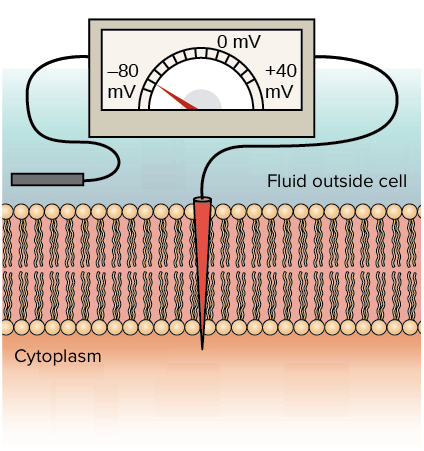
- If the membrane potential becomes more positive than it is at the resting potential, the membrane is said to be depolarized.
- If the membrane potential becomes more negative than it is at the resting potential, the membrane is said to be hyperpolarized.
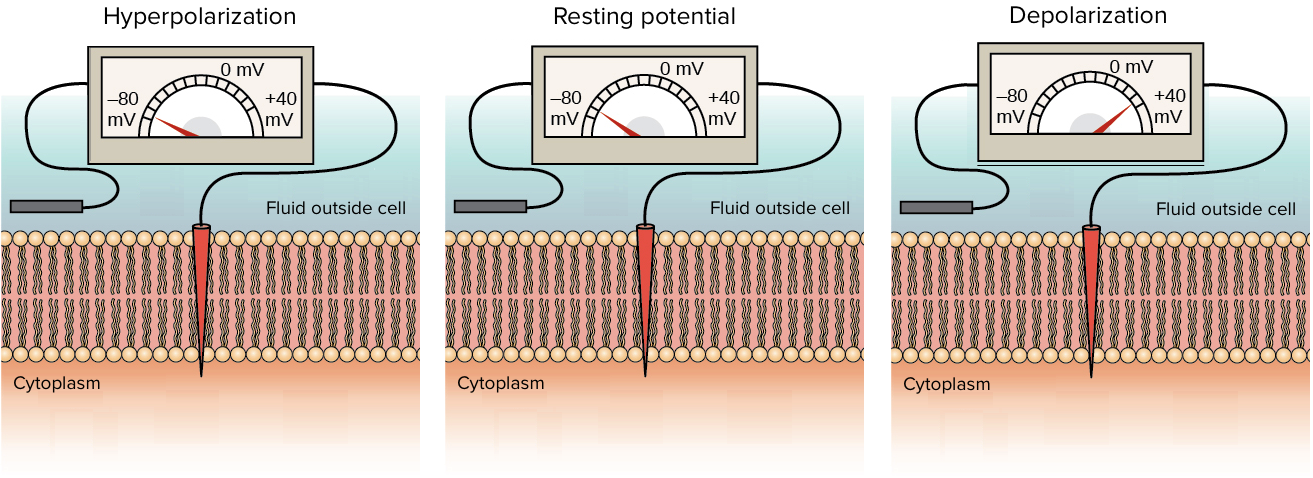
Where does the resting membrane potential come from?
Types of ions found in neurons
- Positively charged (cations): Sodium (\text{Na}^+Na+start text, N, a, end text, start superscript, plus, end superscript) and potassium (\text{K}^+K+start text, K, end text, start superscript, plus, end superscript)
- Negatively charged (anions): Chloride (\text{Cl}^-Cl−start text, C, l, end text, start superscript, minus, end superscript) and organic anions

- K+ is more concentrated inside than outside the cell.
- Organic anions are more concentrated inside than outside the cell.
- Cl- is more concentrated outside than inside the cell.
- Na+ is more concentrated outside than inside the cell.
How ions cross the membrane
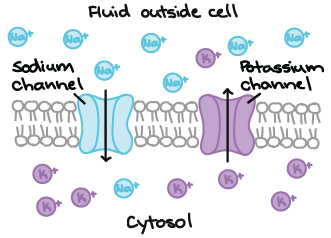
Some ion channels are highly selective for one type of ion, but others let various kinds of ions pass through. Ion channels that mainly allow \text{K}^+K+start text, K, end text, start superscript, plus, end superscript to pass are called potassium channels, and ion channels that mainly allow \text{Na}^+Na+start text, N, a, end text, start superscript, plus, end superscript to pass are called sodium channels.
What happens if only \text K^+K+start text, K, end text, start superscript, plus, end superscript can cross the membrane?
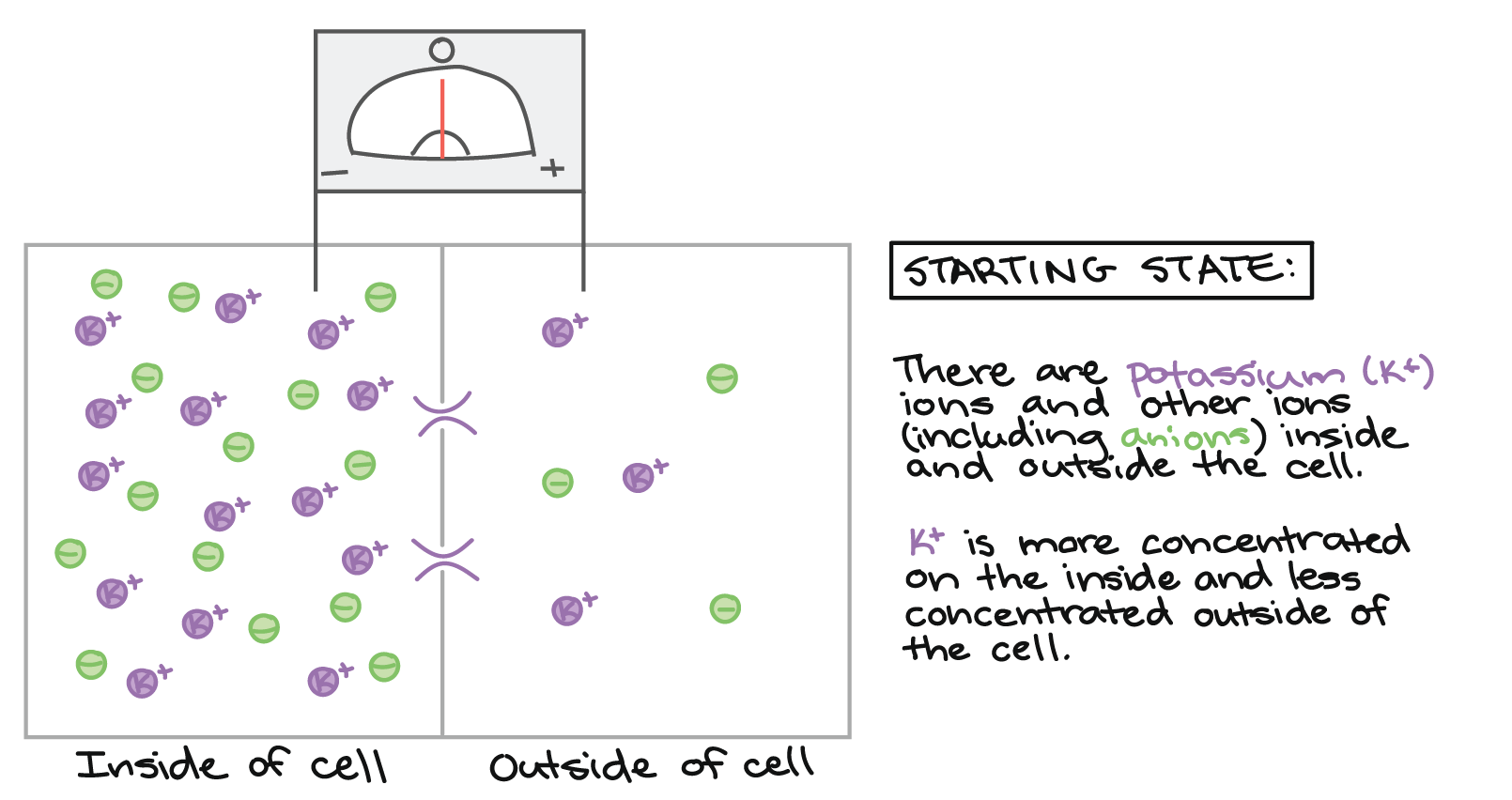
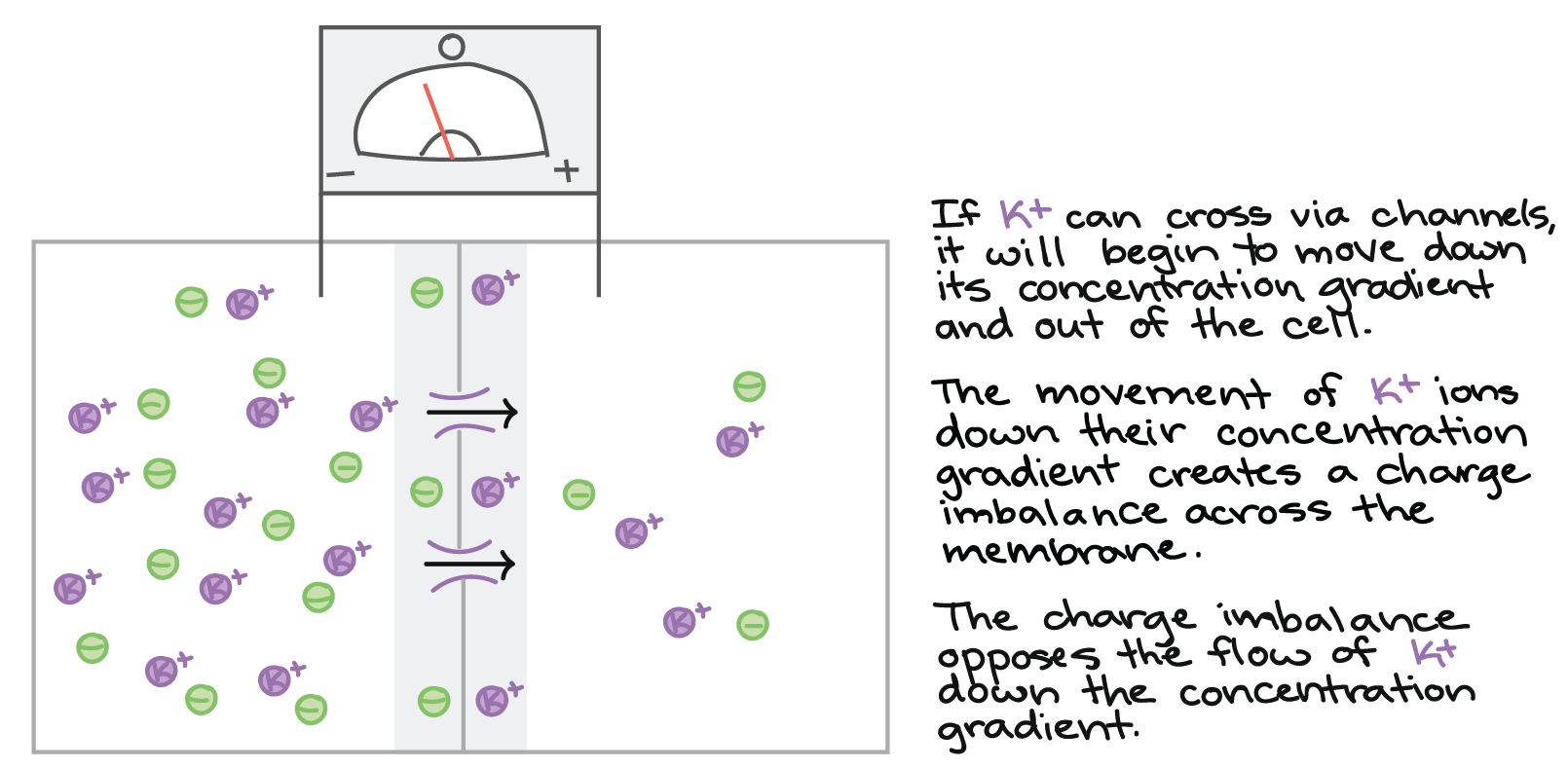
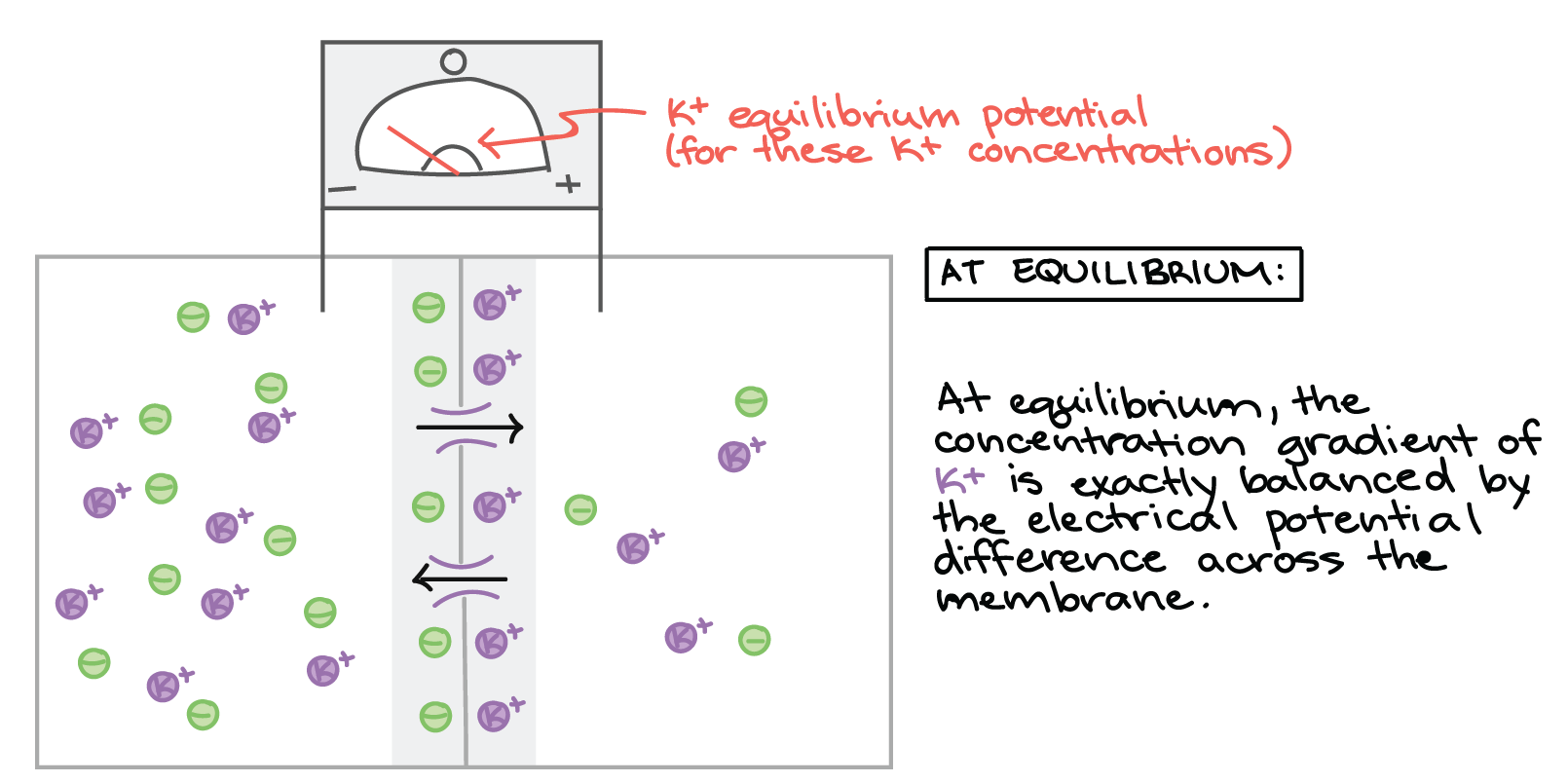
The equilibrium potential

Does membrane potential equal \text K^+K+start text, K, end text, start superscript, plus, end superscript equilibrium potential?
Both \text K^+K+start text, K, end text, start superscript, plus, end superscript and \text {Na}^+Na+start text, N, a, end text, start superscript, plus, end superscript contribute to resting potential in neurons

- \text{Na}^+Na+start text, N, a, end text, start superscript, plus, end superscript will try to drag the membrane potential toward its (positive) equilibrium potential.
- \text{K}^+K+start text, K, end text, start superscript, plus, end superscript will try to drag the membrane potential toward its (negative) equilibrium potential.
Opening and closing ion channels alters the membrane potential
- If more potassium channels were to open up—making it even easier for \text{K}^+K+start text, K, end text, start superscript, plus, end superscript to cross the cell membrane—the membrane would hyperpolarize, getting even closer to the potassium equilibrium potential.
- If, on the other hand, additional sodium channels were to open up—making it easier for \text{Na}^+Na+start text, N, a, end text, start superscript, plus, end superscript to cross the membrane—the cell membrane would depolarize toward the sodium equilibrium potential.
The \text{Na}^+Na+start text, N, a, end text, start superscript, plus, end superscript–\text K^+K+start text, K, end text, start superscript, plus, end superscriptpump maintains \text{Na}^+Na+start text, N, a, end text, start superscript, plus, end superscript and \text{K}^+K+start text, K, end text, start superscript, plus, end superscript gradients
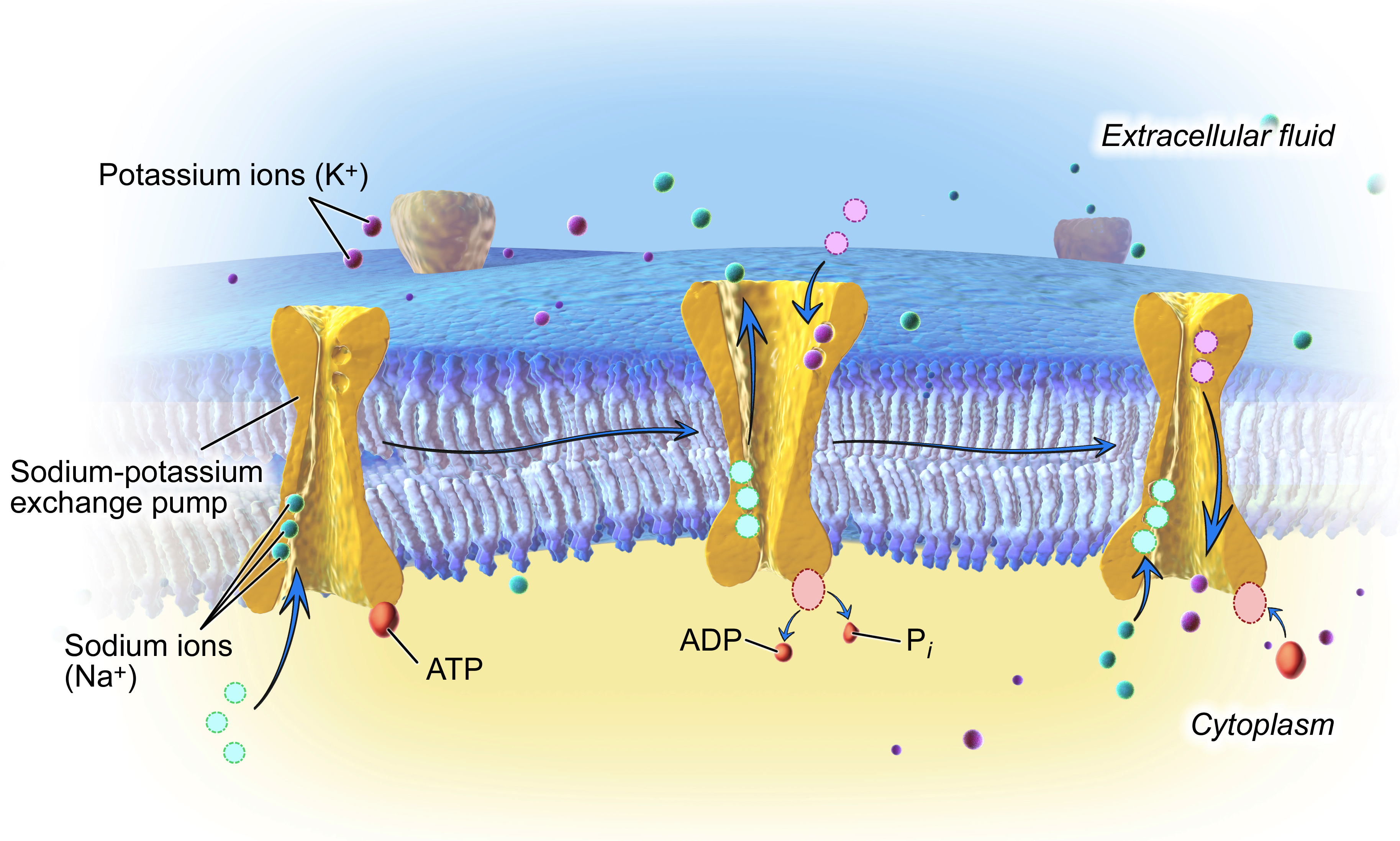
- Three sodium ions bind to the sodium-potassium pump, which is open to the interior of the cell.
- The pump hydrolyzes ATP, phosphorylating itself (attaching a phosphate group to itself) and releasing ATP. This phosphorylation event causes a shape change in the pump, in which it closes off on the inside of the cell and opens up to the exterior of the cell. The three sodium ions are released, and two potassium ions bind to the interior of the pump.
- The binding of the potassium ions triggers another shape change in the pump, which loses its phosphate group and returns to its inward-facing shape. The potassium ions are released into the interior of the cell, and the pump cycle can begin again.
Sort by:
Want to join the conversation?
- 4 years agoPosted 4 years ago. Direct link to kakarorahahai’s post “please correct me if i am…”please correct me if i am wrong…this what i understood from this article:
-we assume that initially there is electrical neutrality across the membrane.
-then if channels are present they allow the movement of sodium and potassium ions and leads to the development of constant membrane potential.
-now as the membrane potential is constant the charges leaving the cell must equal the charge entering .
-na k pump maintains concentrations as some leakage of ions still take place.AnswerAnswer kakarorahahai’s post “please correct me if i am…”Button opens signup modal•
CommentComment on kakarorahahai’s post “please correct me if i am…”Button opens signup modal(7 votes)
Upvote
Button opens signup modalDownvote
Button opens signup modalFlag
Button opens signup modalmore - 6 years agoPosted 6 years ago. Direct link to Pruthviraj Tarade’s post “do our physical movement…”do our physical movements affect ion exchange?AnswerAnswer Pruthviraj Tarade’s post “do our physical movement…”Button opens signup modal
•
Comment on Pruthviraj Tarade’s post “do our physical movement…”(9 votes)
Upvote
Button opens signup modalDownvote
Button opens signup modalFlag
Button opens signup modalmore- 6 years agoPosted 6 years ago. Direct link to Alexander’s post “physical movement would c…”
 physical movement would cause afferent sensory neurons to fire and yourself to notice that you are moving. Also moving itself would cause afferent neurons to send action potentials to the muscles, which affects the ion exchange.CommentComment on Alexander’s post “physical movement would c…”Button opens signup modal
physical movement would cause afferent sensory neurons to fire and yourself to notice that you are moving. Also moving itself would cause afferent neurons to send action potentials to the muscles, which affects the ion exchange.CommentComment on Alexander’s post “physical movement would c…”Button opens signup modal(10 votes)
Upvote
Button opens signup modalDownvote
Button opens signup modalFlag
Button opens signup modalmore
I understand the mechanisms, but what is the actual point in maintaining the concentration gradients?
As the article states, if the sodium/potassium pump ceased to function, the concentration gradients would dissipate. If the whole purpose of the concentration gradients is to create an action potential, why can’t the membrane be non polar and then instead of depolarising the membrane at threshold, it would merely, polarise it? this would still create an action potential would it not? I don’t understand WHY there is a whole mechanism to maintain these gradients when an action potential could still be created if the membrane at rest was non polar.Is it because there wouldn’t really be an resting membrane potential? I.e the membrane would never truly be at rest because of the different permeabilities and equilibrium potentials of the ions? Therefore an action potential would not be able to be created.. But if there was Na+ constantly moving in and K+ constantly moving out, why would this not keep a constant membrane potential?
AnswerAnswer celina v’s post “I understand the mechanis…”Button opens signup modal•
CommentComment on celina v’s post “I understand the mechanis…”Button opens signup modal(5 votes)
Upvote
Button opens signup modalDownvote
Button opens signup modalFlag
Button opens signup modalmore- I think it is because it is easier and faster to depolarize the membrane than to polarize it. The sodium/potassium pump needs energy and time to clear the intracellular space from sodium, and I guess it would be quite ineffective to take this mechanism for impulse transfer.
And what one might forget is that every cell has a concentration gradient! I even heard it as a definition of life, to have a specific concentration of ions which is not the same as the one surrounding the cell. This concentration gradient is important for metabolic processes, i.e. to build new molecules or to break them down, and for the osmosis – water always tries to equal concentration differences out by going towards the more salty regions. That is how we absorb water and why people can’t drink sea water, for example.
So the resting potential is very important.Comment on Okapi’s post “I think it is because it …”(3 votes)
Upvote
Button opens signup modalDownvote
Button opens signup modalFlag
Button opens signup modalmore
- Why Cl is not contributing much to the resting potential. More importantly, why the Cl does not move into the cell during action potential when the electrochemical gradient (charge and concentration) is in favor for Cl to move in?AnswerAnswer HUH AL’s post “Why Cl is not contributin…”Button opens signup modal
•
CommentComment on HUH AL’s post “Why Cl is not contributin…”Button opens signup modal(4 votes)
Upvote
Button opens signup modalDownvote
Button opens signup modalFlag
Button opens signup modalmore- The membrane is relatively impermeable to Cl-, yes, but Cl- influence is also reduced because its equilibrium potential is already close to the resting membrane potential (I believe Cl- equilibrium potential is around ~71mV)! Keep in mind the equilibrium potential of ions that the membrane is more permeable to has a greater impact on resting potential than that of ions the membrane is less permeable to. So even if permeability to Cl- increased, I’m fairly certain the value of the resting potential still wouldn’t be greatly affected. 🙂Comment on Jen’s post “The membrane is relativel…”
(3 votes)
Upvote
Button opens signup modalDownvote
Button opens signup modalFlag
Button opens signup modalmore
- 5 years agoPosted 5 years ago. Direct link to Shaine Galarce Sarmiento’s post “Brief but detailed summar…”Brief but detailed summary of how resting membrane potential is generatedAnswerAnswer Shaine Galarce Sarmiento’s post “Brief but detailed summar…”Button opens signup modal
•
CommentComment on Shaine Galarce Sarmiento’s post “Brief but detailed summar…”Button opens signup modal(2 votes)
Upvote
Button opens signup modalDownvote
Button opens signup modalFlag
Button opens signup modalmore- Resting membrane potential is generated by the combination of sodium and potassium pump and the leak channels of these ions. The function of the pump is to take out three sodium from the cell and two potassium into the cell with the use of ATP (changes the shape of pump to release these ions), already with the stoichiometry difference, we see a charge difference. Furthermore, because it is more postive outside of the cell, and negative inside the cell, plasma membrane becomes more permeable to Potassium on our leak channels. Therefore, even with leak channels of both ions, potassium is more permeable. Causing a standard measurement of -70mV resting potentialCommentComment on student’s post “Resting membrane potentia…”Button opens signup modal
(6 votes)
Upvote
Button opens signup modalDownvote
Button opens signup modalFlag
Button opens signup modalmore
- 5 years agoPosted 5 years ago. Direct link to menal kameel’s post “at resting membrane poten…”at resting membrane potenital do Na go in and K out? i cant understand resting membrane potentialAnswerAnswer menal kameel’s post “at resting membrane poten…”Button opens signup modal
•
CommentComment on menal kameel’s post “at resting membrane poten…”Button opens signup modal(3 votes)
Upvote
Button opens signup modalDownvote
Button opens signup modalFlag
Button opens signup modalmore- 4 years agoPosted 4 years ago. Direct link to vedant vani’s post “Resting membrane potentia…”Resting membrane potential of a neuron is about -70mV which means that the inside of the neuron is 70mV less than the outside. There are more k and less NA+ inside and more NA+ and less K+ outside. It is because the cell membrane is selectively permeable which means that is allows some substances to come in while restricting the others. The cell membrane is selectively more permeable to K than Na and hence there are more k inside than the outside, and hence outside is more positive then the inside.CommentComment on vedant vani’s post “Resting membrane potentia…”Button opens signup modal
(2 votes)
Upvote
Button opens signup modalDownvote
Button opens signup modalFlag
Button opens signup modalmore
- Why is Chloride’s membrane potential negative despite having a higher extracellular concentration?AnswerAnswer Emed1’s post “Why is Chloride’s membran…”Button opens signup modal
•
CommentComment on Emed1’s post “Why is Chloride’s membran…”Button opens signup modal(3 votes)
Upvote
Button opens signup modalDownvote
Button opens signup modalFlag
Button opens signup modalmore- 3 years agoPosted 3 years ago. Direct link to Ivana – Science trainee’s post “IT is true, Cl- ions are …”
IT is true, Cl- ions are more concentrated on the outside than on the inside.
I can answer why is intracellular more negative – due to differences in Na/K plus die to exist negatively charged proteins in the cell.
CommentComment on Ivana – Science trainee’s post “IT is true, Cl- ions are …”Button opens signup modal(1 vote)
Upvote
Button opens signup modalDownvote
Button opens signup modalFlag
Button opens signup modalmore
- 6 years agoPosted 6 years ago. Direct link to Dilayaykan’s post “what happens when the con…”what happens when the concentration of Na is increased in the extracellular fluid, is there a depolarization or hyperpolarization?
And the same goes for the increased concentration of K in the extracellular fluid, is there a depolarization or hyperpolarization?AnswerAnswer Dilayaykan’s post “what happens when the con…”Button opens signup modal•
Comment on Dilayaykan’s post “what happens when the con…”(2 votes)
Upvote
Button opens signup modalDownvote
Button opens signup modalFlag
Button opens signup modalmore- When Na is increased in the ECF it will not have any major affect on the cell, a negligible depolarization if even measurable because the higher outside gradient will help push the Na into the cell (but remember that it isn’t very permeable so it’s minute).
K will have a bigger effect because the extra ECF will decrease the internal leakage of K from ICF to ECF because there would be a higher gradient outside now. The end result would be in depolarizing the cell, how much would depend on how much K was added to the ECF.Comment on James’s post “When Na is increased in t…”(4 votes)
Upvote
Button opens signup modalDownvote
Button opens signup modalFlag
Button opens signup modalmore
- 2 years agoPosted 2 years ago. Direct link to Nullie James’s post “in what ways is the Na+/K…”in what ways is the Na+/K+ pump different from the K+ channelAnswerAnswer Nullie James’s post “in what ways is the Na+/K…”Button opens signup modal
•
CommentComment on Nullie James’s post “in what ways is the Na+/K…”Button opens signup modal(2 votes)
Upvote
Button opens signup modalDownvote
Button opens signup modalFlag
Button opens signup modalmore - 3 years agoPosted 3 years ago. Direct link to Qasim Hashmi’s post “why do the potassium and …”why do the potassium and the sodium become ions?AnswerAnswer Qasim Hashmi’s post “why do the potassium and …”Button opens signup modal
•
CommentComment on Qasim Hashmi’s post “why do the potassium and …”Button opens signup modal(2 votes)
Upvote
Button opens signup modalDownvote
Button opens signup modalFlag
Button opens signup modalmore- 3 years agoPosted 3 years ago. Direct link to Ivana – Science trainee’s post “First, defintion of an io…”
First, defintion of an ion:
‘an atom or molecule with a net electric charge due to the loss or gain of one or more electrons.’
https://www.lexico.com/en/definition/ionSo, we have ions in our cells and extracellular matrix.
Since redox reactions happen in our body, as a consequence we have ions.Which is more important, because our nervous sysem relies on transmitting neural signal (electrical current) we have to create that electrical field somehow – that’s why we have ions.
Now, the change in concentration inside and outsid eof cell helps creating resting emmbrane potential, depolarization, repolarization and generating action potential (that’s how signal is porpagated).
Action potential jumps from Ranvier node to another and that way is faster conducted until it reaches synapse or final destination – where it is transmitted into sensation (in our brain) or into some action (efferent pathways).
Something as complicated as sensing that truck is runnign towards you while you are crossing the road (sorry if my example is morbid) all relies on little Na and K ions. And channels for Na and K as well. All down to the level of atoms and molecules (Biology cannot exist without Chemistry or Physics).
Comment